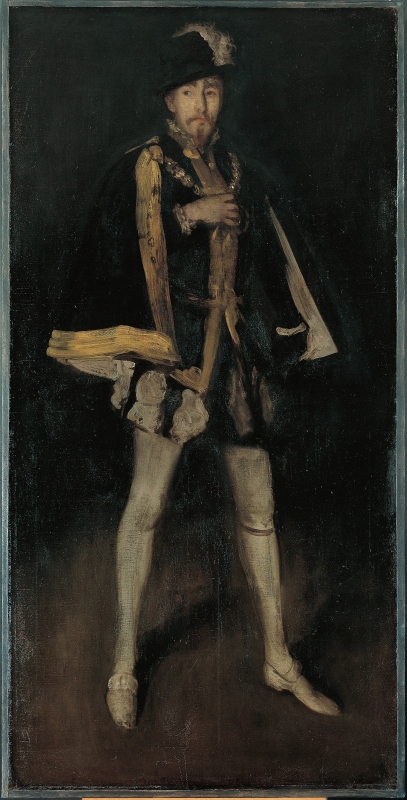Composition
Whistler's technique has been frequently compared to that of Diego Rodriguez de Silva y Velázquez (1599-1660), and the pose itself, in reverse, is similar to that of the portrait of Pablo de Valladolid by Velázquez, in the Prado, of which Whistler owned a photograph, and which has also been seen as the source for a self-portrait, Brown and Gold [YMSM 440].

Arrangement in Black, No. 3: Sir Henry Irving as Philip II of Spain, early state, photograph, GUL Whistler PH4/19
Marie Spartali (Mrs W. J. Stillman) (1844-1927) noticed that 'three different outlines of the figure were visible' when Arrangement in Black, No. 3: Sir Henry Irving as Philip II of Spain [YMSM 187] was exhibited in 1877. 1
Photographs of the portrait in an early state are in the Whistler collection in Special Collections, Glasgow University Library, the G. A. Lucas Collection in Baltimore Museum of Art, and the S. P. Avery Collection in New York Public Library. 2 X-radiographs confirm the evidence of these photographs. The Lucas photograph is inscribed in Whistler's hand: 'Arrangement in Black, No. 2 [sic] Henry Irving as Philip 3 [sic] of Spain'. The Avery photograph is signed with a butterfly of about 1876/1877 and inscribed by Whistler: 'To S. P. Avery, "Arrangement in Black No. 3 Portrait of Henry Irving – as Philip II"/ Whistler/ Present condition – unfinished'; beneath, in another hand, possibly Avery's, '(never finished)'. The Avery photograph clearly shows trickles of paint, especially between Irving's legs and over his foot on the right.
Further changes were made to the portrait in the second sittings of about 1885. In the earlier state the sitter does not wear a chain round his neck, and has no garter or shoes. Most strikingly, the cloak, which hung loosely from the shoulders in the earlier state, appears thrown forward over the sitter's right shoulder in the finished composition.
Two drypoints, Irving as Philip of Spain, No. 1 [158] and Irving as Philip of Spain, No. 2 [159], which were possibly started in 1876, and seen by Alan Summerly Cole (1846-1934) in January 1877, relate to the earlier rather than the final state of the composition. 3
The photograph of the portrait reproduced as frontispiece to The Drama: Addresses by Henry Irving in 1893 appears to show the painting in an intermediate state, after which a few touches were added to the chain and to the lower edge of the cloak on the left.
Technique
At the Ruskin-Whistler trial in 1878 Whistler was asked by John Humffrey Parry (1824-1880) if the portrait was 'a finished picture', and replied, 'It is a large impression – a sketch; but it was not intended as a finished picture.' Re-examined on the point, he insisted that it was 'a mere sketch unfinished.' 4
It is thinly painted, and rather dark, though the lighter areas – gold on the chain, cloak and the jacket, and white or grey on the breeches and tights – are painted boldly, with sweeping broad-brush curves. The face is carefully modelled and more soft, with the features delineated precisely with smaller brushes, and white highlights on his eyes. The feathers in the hat are also painted with a small brush, but with expressive, freely curving strokes.
Conservation History
It was painted on a dark ground and it has darkened slightly. There is also some cracking overall and slight abrasion at the edges.
Frame
Flat Whistler frame, with alterations, ca 1900 [12 cm]. 5
Notes:
1: Pennell 1911 A [more] , p. 144.
2: See also Duret 1904 [more] , repr. p. 63.
3: Margaret F. MacDonald, Grischka Petri, Meg Hausberg, and Joanna Meacock, James McNeill Whistler: The Etchings, a catalogue raisonné, University of Glasgow, 2012, website at http://etchings.arts.gla.ac.uk (G.158-59).
4: Merrill 1992 [more] ; see also the record of Whistler's examination, High Court of Justice to J. A. Rose, 25 November 1878, GUW #11991.
5: Dr Sarah L. Parkerson Day, Report on frames, 2017; see also Parkerson 2007 [more] .
Last updated: 7th June 2021 by Margaret









